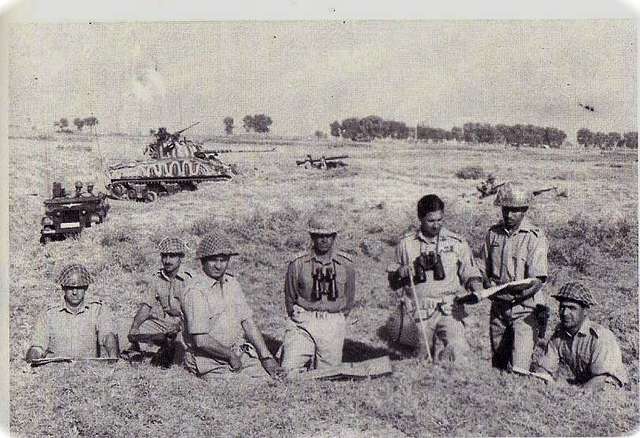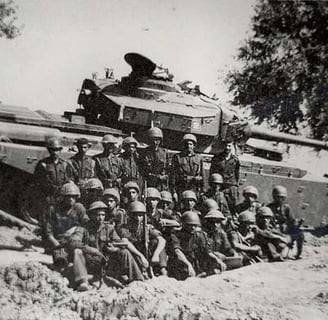"Battle of Chawinda 1965: Indo-Pak War’s Largest Tank Battle | Tactics & Outcome"
"Explore the 1965 Battle of Chawinda: Indo-Pak War’s epic tank clash. Discover tactics, heroes, and who won history’s fiercest post-WWII armored battle."


Introduction: The Pivotal Clash That Defined the 1965 Indo-Pak War
The Battle of Chawinda (September 1965) remains one of the most intense confrontations in South Asian military history. Dubbed the "Battle of Patton’s Graveyard" (referencing destroyed US-made Pakistani tanks), this clash saw over 200 tanks, artillery duels, and heroic stands that halted India’s advance into Pakistan’s heartland. In this Article, we uncover tactical blunders, unsung heroes, and why Chawinda became a symbol of resilience. The word's first largest tank battle
1. Historical Context: Why Chawinda Mattered
Operation Grand Slam & Pakistan’s Kashmir Offensive
Pakistan launched Operation Gibraltar in August 1965, infiltrating Kashmir to spark a rebellion.
India retaliated with Operation Grand Slam, aiming to cut off Pakistan’s supply route to Kashmir by capturing Akhnur.
Pakistan’s counterattack pushed India to shift focus to the Sialkot sector, setting the stage for Chawinda.
Strategic Importance of Chawinda
Chawinda was a railway junction linking Sialkot (Pakistan) to Jammu (India).
Capturing Chawinda would give India access to the G.T. Road, threatening Lahore and Rawalpindi.
2. Forces & Equipment: A Tank Battle for the Ages
Pakistani Defenders
6th Armoured Division: Led by Maj. Gen. Abrar Hussain, equipped with M48 Patton tanks (US-made).
24th Infantry Brigade: Supported by artillery regiments and anti-tank guns.
Indian Attackers
1st Armoured Division: Commanded by Maj. Gen. Rajinder Singh Sparrow, featuring Centurion and Sherman tanks.
14th Infantry Division: Tasked with securing Chawinda’s flanks.
Key Fact: Pakistan’s Pattons had superior firepower, but India’s Centurions boasted better armor.
3. Timeline of the Battle: Day-by-Day Breakdown
Phase 1: Indian Advance (Sept 8–11)
Sept 8: India’s 1st Armoured Division crossed the Basantar River, capturing Phillora.
Sept 11: Pakistani forces regrouped at Chawinda, digging trenches and deploying anti-tank mines.
Phase 2: Pakistani Counterattack (Sept 12–19)
Sept 12: Pakistan’s 6th Armoured Division ambushed Indian tanks near Gadgor, destroying 30+ Centurions.
Sept 14: Fierce fighting at Jassoran and Alhar villages. Indian infantry faced heavy artillery shelling.
Sept 19: Stalemate ensued as both sides suffered massive losses. The UN-mandated ceasefire halted operations.
4. Tactical Turning Points: Why Pakistan Held Its Ground
1. Defensive Genius of Maj. Gen. Abrar Hussain
Hussain deployed minefields and tank ditches to funnel Indian tanks into kill zones.
Used reverse slope defense: Hiding tanks behind ridges to ambush advancing forces.
2. India’s Logistical Nightmares
Fuel shortages crippled India’s armored thrust.
Poor coordination between infantry and tank units left flanks exposed.
3. Role of Pakistani Artillery
25-pounders and 105mm howitzers rained shells on Indian supply lines.
Brig. Abdul Ali Malik’s artillery regiment destroyed 40+ Indian tanks.
5. Heroic Acts & Untold Stories
Major Shabbir Sharif (Pakistan)
Led a company at Barki Sector, destroying 6 Indian tanks in a single day. Awarded the Nishan-e-Haider (Pakistan’s highest military honor).
Havildar Abdul Hamid (India)
Destroyed 7 Patton tanks with a recoilless rifle before being martyred. Awarded the Param Vir Chakra.
The "Ghost Tanks" of Chawinda
Pakistani forces used dummy tanks made of wood and canvas to mislead Indian pilots.
6. Outcome & Legacy: Who Won the Battle of Chawinda?
Tactical Stalemate: Neither side achieved territorial gains, but Pakistan defended critical ground.
Human Cost: 3,000+ casualties combined; 100+ tanks destroyed.
Strategic Impact:
Exposed flaws in India’s armored warfare tactics.
Cemented Pakistan’s reliance on US military hardware.
Shaped future Indo-Pak military doctrines.
FAQs
Q: What was the largest tank battle in the Indo-Pak Wars?
A: Chawinda (1965), with over 200 tanks engaged, surpassed even the 1971 War’s battles.
Q: Why is Chawinda called "Patton’s Graveyard"?
A: Over 70 Pakistani M48 Patton tanks were destroyed, exposing vulnerabilities in US-supplied armor.
Q: Did India ever capture Chawinda?
A: No. Despite initial gains, India withdrew post-ceasefire, leaving Chawinda under Pakistani control.
Q: How did the UN impact the battle?
A: The UN Security Council enforced a ceasefire on Sept 22, freezing territorial positions.
Conclusion: Chawinda’s Lessons in Modern Warfare
The Battle of Chawinda underscores the importance of logistics, terrain mastery, and adaptability in warfare. While both nations claim victory, the real legacy lies in its lessons for future conflicts.


